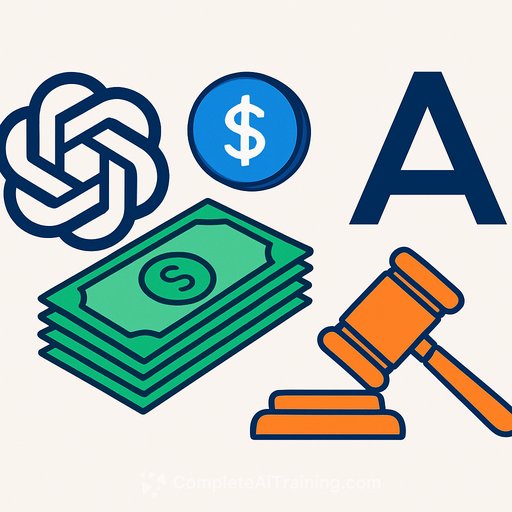AI lawsuits are outgrowing insurance capacity - what carriers and brokers should do now
Two AI leaders are weighing investor funds to settle major lawsuits because insurance won't cover the full exposure. OpenAI faces author and media copyright claims that could reach billions, plus a wrongful-death suit tied to alleged ChatGPT use. Anthropic has preliminary court approval to pay $1.5 billion to authors, with part of the payout coming from its own cash. This is a signal: AI liability is scaling faster than traditional capacity can match.
The numbers worth underwriting
- OpenAI has some coverage via Aon; reports suggest limits up to $300 million - far below potential damages.
- OpenAI has raised about $60 billion, giving it a backstop beyond insurance.
- Anthropic's proposed $1.5 billion author settlement will draw on company funds; it has raised about $32 billion.
- Carrier capacity and pricing methods are lagging the scale, similar to early cyber market dynamics.
Why this matters for insurers
Loss severity is concentrated in copyright, defamation, data misuse, and safety harms tied to model outputs. Frequency is still uncertain; severity is not. Claims are also correlated across clients that rely on similar foundation models and data sources. That correlation can break standard diversification assumptions inside a book.
Legal outcomes and damages frameworks are still forming, which makes historical modeling weak. This mirrors early cyber: limited loss history, fast-changing attack vectors, and cluster risk. Expect higher premiums, tighter wording, and smaller limits until better data and segmentation emerge.
Underwriting checklist for AI exposures
- Training data governance: provenance tracking, licensing posture, opt-outs, takedown processes.
- Model pipeline: release gates, red-teaming, evals for copyright and safety risks, rollback plans.
- Content filters and guardrails: coverage for bypass risks, human-in-the-loop thresholds.
- Telemetry: output logging, prompt retention policies, traceability for incident response.
- Vendor stack: indemnities from model/API providers, subprocessor mapping, contract caps.
- User terms: acceptable-use, disclaimers, age gating, content ownership clauses.
- Incident playbooks: legal triage, PR coordination, preservation of logs and datasets.
Policy design to fit the exposure
- AI/IP endorsement: explicit treatment of copyright, trademark, and training-data claims; clear sublimits.
- Media liability for LLM-generated content, with defined triggers and aggregation language.
- E&O with tech-specific definitions of "professional services" that include model operations.
- Bodily injury/mental harm wording: decide on exclusions or narrow carve-backs for AI-related allegations.
- Defense: inside vs. outside limits; panel counsel with AI/IP expertise.
- Known incidents/retro dates tuned for ongoing datasets and model updates.
- Supplier failure and indemnity gaps: carve-backs where insured relies on third-party models.
Capacity and capital strategy
- Layered towers with tight attachment points; use co-insurance and quota share to spread concentration.
- Reinsurance programs sized for correlated events (e.g., mass copyright actions across insureds).
- Event and claim aggregation wording refined for prompts, outputs, and model versions.
- Encourage client retentions and captives; keep insurer limits disciplined until data matures.
Data and pricing improvements
- Collect model-level telemetry, takedown stats, rights-holder complaints, and red-team results at bind and renewal.
- Scenario models for class actions, statutory damages, and injunctive relief cost (including retraining).
- Benchmark vendor contracts: indemnity caps, audit rights, and patch/update SLAs.
- Feedback loop with claims: map allegations to controls that actually reduced severity.
Broker guidance to clients
- Document training data rights, moderation controls, and incident processes before marketing the risk.
- Negotiate indemnities from AI vendors; push for defense outside limits where possible.
- Build towers early; expect narrower terms and higher rates short-term.
- Plan for self-funded layers or captives to bridge the gap insurers won't fill yet.
Insurers adapted to cyber by raising rates, narrowing coverage, and getting serious about data. Expect a similar path for AI, with bigger numbers and tighter wordings until loss trends stabilize. For a refresher on how markets evolved in cyber, see the NAIC overview here.
If your team needs to educate clients or internal staff on AI risk basics to improve underwriting submissions and controls, browse curated programs by role at Complete AI Training.
Your membership also unlocks:






